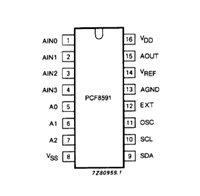AD9901
THEORY OF OPERATION
REFERENCE
INPUT
A phase detector is one of three basic components of a phase-
locked loop (PLL); the other two are a filter and a tunable oscil-
lator. A basic PLL control system is shown in Figure 3.
OSCILLATOR
INPUT
REFERENCE
FLIP-FLOP
OUTPUT
REFERENCE
INPUT
OSCILLATOR
FLIP-FLOP
OUTPUT
LOW-
OSCILLATOR
OUTPUT
PASS
VCO
DC MEAN VALUE
FILTER
XORGATE
OUTPUT
AD9901
1/N
OPTIONAL 1/N PRESCALER
TYPICAL OF DIGITAL PLLs
Figure 6. Timing Waveforms (φOUT Lags φ )
IN
oscillator leading the reference frequency; and with the oscillator
lagging. This output pulse train is low-pass filtered to extract the
dc mean value [Kφ (φI – φO)] where Kφ is a proportionality con-
stant (phase gain).
Figure 3. Phase-Locked Loop Control System
The function of the phase detector is to generate an error signal
that is used to retune the oscillator frequency whenever its out-
put deviates from a reference input signal. The two most com-
mon methods of implementing phase detectors are (1) an analog
mixer and (2) a family of sequential logic circuits known as
digital phase detectors.
At or near lock (Figures 4, 5 and 6), only the two input flip-
flops and the exclusive-OR gate (the phase detection circuit) are
active. The input flip-flops divide both the reference and oscilla-
tor frequencies by a factor of two. This insures that inputs to the
exclusive-OR are square waves, regardless of the input duty
cycles of the frequencies being compared. This division-by-two
also moves the nonlinear detection range to the ends of the
range rather than near lock, which is the case with conventional
digital phase detectors.
The AD9901 is a digital phase detector. As illustrated in the
block diagram of the unit, straightforward sequential logic de-
sign is used. The main components include four “D” flip-flops,
an exclusive-OR gate (XOR) and some combinational output
logic. The circuit operates in two distinct modes: as a linear
phase detector and as a frequency discriminator.
Figure 7 illustrates the constant gain near lock.
When the reference and oscillator are very close in frequency,
only the phase detection circuit is active. If the two inputs are
substantially different in frequency, the frequency discrimina-
tion circuit overrides the phase detector portion to drive the
oscillator frequency toward the reference frequency and put it
within range of the phase detector.
2
F
= 70MHz
O
F
= 200MHz
O
F
= 50MHz
O
Input signals to the AD9901 are pulse trains, and its output
duty cycle is proportional to the phase difference of the oscilla-
tor and reference inputs. Figures 4, 5 and 6 illustrate, respec-
tively, the input/output relationships at lock; with the
1
TYPICAL PHASE DETECTOR
GAIN IS 0.2865V/RAD
⌬V
= 1.8V
OUT
REFERENCE
INPUT
OSCILLATOR
INPUT
0
–2
0
–
PHASE DIFFERENCE AT INPUTS
REFERENCE
FLIP-FLOP
OUTPUT
Figure 7. Phase Gain Plot
OSCILLATOR
FLIP-FLOP
When the two square waves are combined by the XOR, the
output has a 50% duty cycle if the reference and oscillator in-
puts are exactly 180° out of phase; under these conditions, the
AD9901 is operating in a locked mode. Any shift in the phase
relationship between these input signals causes a change in the
output duty cycle. Near lock, the frequency discriminator flip-
flops provide constant HIGH levels to gate the XOR output to
the final output.
OUTPUT
DC MEAN VALUE
XORGATE
OUTPUT
Figure 4. AD9901 Timing Waveforms at “Lock”
REFERENCE
INPUT
OSCILLATOR
INPUT
The duty cycle of the AD9901 is a direct measure of the phase
difference between the two input signals when the unit is near
lock. The transfer function can be stated as [Kφ(φI – φO](V/RAD),
where Kφ is the allowable output voltage range of the AD9901
divided by 2 π.
REFERENCE
FLIP-FLOP
OUTPUT
OSCILLATOR
FLIP-FLOP
OUTPUT
DC MEAN VALUE
For a typical output swing of 1.8 V, the transfer function can be
stated as (1.8 V/2 π = 0.285 V/RAD). Figure 7 shows the rela-
tionship of the dc mean value of the AD9901 output as a func-
tion of the phase difference of the two inputs.
XORGATE
OUTPUT
Figure 5. Timing Waveforms (φOUT Leads φIN)
–6–
REV. B






 STM32F030C6芯片介绍:主要参数分析、引脚配置说明、功耗及封装
STM32F030C6芯片介绍:主要参数分析、引脚配置说明、功耗及封装

 PCF8591数据手册解读:参数、引脚说明
PCF8591数据手册解读:参数、引脚说明

 一文带你了解ss8050参数、引脚配置、应用指南
一文带你了解ss8050参数、引脚配置、应用指南

 深入解析AD7606高性能多通道模数转换器:资料手册参数分析
深入解析AD7606高性能多通道模数转换器:资料手册参数分析
